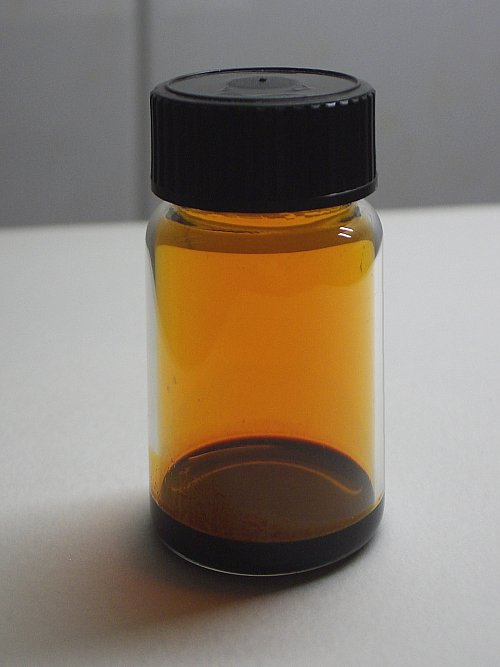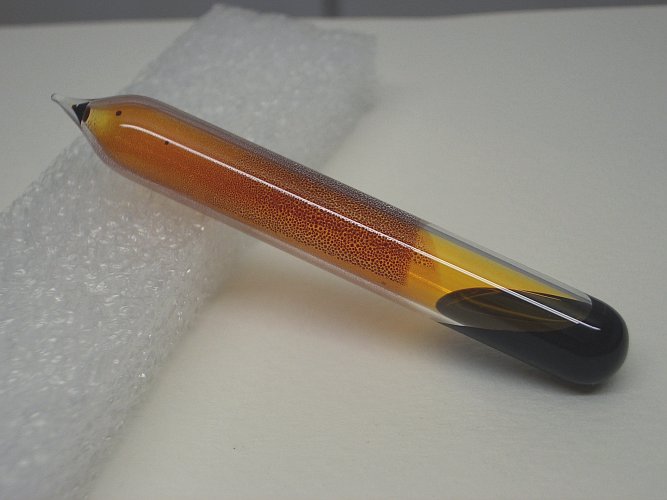


Bromine
 Chemically speaking, bromine resembles the element chlorine. It is a very
reactive element, although less so than chlorine.
Chemically speaking, bromine resembles the element chlorine. It is a very
reactive element, although less so than chlorine.
Bromine is a very volatile dark brown liquid at room temperature, which gives a thick red/brown vapor, when it evaporates. It is only sparingly soluble in water. However, when a soluble bromide is dissolved in the water, then the solubility increases considerably. The picture shows liquid bromine, which is very dark red, almost black, and bromine vapor.
![]() Experiments with
bromine should not be conducted inside, unless one has a good fume hood. A
standard kitchen exhaust is not sufficient for working with bromine. Elementary
bromine is very toxic. It has a strong choking smell, which, like the smell of
chlorine, is quite characteristic, although quite different from the smell of
chlorine. Most people, who once have smelled bromine,
later on recognize the smell easily.
Experiments with
bromine should not be conducted inside, unless one has a good fume hood. A
standard kitchen exhaust is not sufficient for working with bromine. Elementary
bromine is very toxic. It has a strong choking smell, which, like the smell of
chlorine, is quite characteristic, although quite different from the smell of
chlorine. Most people, who once have smelled bromine,
later on recognize the smell easily.
Bromine can easily be prepared with common chemicals, but that must be done with care, due to its toxicity. It is a very reactive chemical, which can be used in many interesting experiments. On this site there are several experiments, in which elementary bromine is used. This bromine is made, when it is needed. One should not store bromine, nor as vapor, nor as liquid nor as solution in water! Bromine almost 'eats' everything, and when it is stored for a longer time, then it certainly destroys the cap of the bottle in which it is stored. If it escapes, it spoils everything, stored nearby.
Sometimes bromine in its elemental form is offered on eBay as an item for element collections. It also is offered by specialized element collection sellers. For safety reasons the bromine always is offered in sealed glass ampoules, which contain an amount in the order of magnitude of 1 gram. An example of such an ampoule is shown below. These ampoules are very nice for display purposes, but they are too expensive for real chemical experiments (the price ranges between $15 and $50, depending on the size of the sample).

![]()
Bromine probably exists in all of the oxidation states -1 to +7, but at room temperature, only oxidation states -1, 0, +5 and +7 are stable. For the home chemist, the number of bromine compounds, which are available is limited. All of the compounds, mentioned below, are interesting.
- sodium bromide, NaBr
- potassium bromide, KBr
- potassium bromate, KBrO3
Although potassium perbromate, KBrO4, is stable and even quite inert, just as potassium perchlorate, it is only known since the 1960's. This remarkable fact is due to the difficulties in finding a mechanistic pathway for preparing perbromate ions. Even now, perbromates are only curiosities in the lab.
![]() Sodium bromide and potassium bromide are available from photography raw chemical
suppliers. Both of these are soluble white crystalline solids. The salts
themselves are not that interesting. They are fairly unreactive. These salts,
however, are a nice source for elementary bromine. Bromide ion can easily be
oxidized to elementary bromine.
Sodium bromide and potassium bromide are available from photography raw chemical
suppliers. Both of these are soluble white crystalline solids. The salts
themselves are not that interesting. They are fairly unreactive. These salts,
however, are a nice source for elementary bromine. Bromide ion can easily be
oxidized to elementary bromine.
![]() Potassium bromate is a white crystalline solid, which is only sparingly soluble
in water. It also can be dissolved in dilute sulphuric acid without
decomposition. Bromate ion is a strong oxidizer in acidic media. With bromide
ion, elementary bromine is formed. The redox chemistry of bromate ion is much
more simple than the redox chemistry of chlorate. Bromate either is reduced to
bromide or to bromine. Potassium bromate can be obtained as special order
chemical from some photography raw chemical suppliers. For aqueous chemistry
experiments, potassium bromate only is of limited interest. Potassium bromate is
fairly
convenient as a source for elementary bromine, when combined with bromides.
Potassium bromide can be made
fairly easily from potassium bromide.
Potassium bromate is a white crystalline solid, which is only sparingly soluble
in water. It also can be dissolved in dilute sulphuric acid without
decomposition. Bromate ion is a strong oxidizer in acidic media. With bromide
ion, elementary bromine is formed. The redox chemistry of bromate ion is much
more simple than the redox chemistry of chlorate. Bromate either is reduced to
bromide or to bromine. Potassium bromate can be obtained as special order
chemical from some photography raw chemical suppliers. For aqueous chemistry
experiments, potassium bromate only is of limited interest. Potassium bromate is
fairly
convenient as a source for elementary bromine, when combined with bromides.
Potassium bromide can be made
fairly easily from potassium bromide.


![]() Potassium bromate, like potassium chlorate, is quite dangerous, when used in
dry-chemical mixtures.
Mixtures of bromates with reducing agents, such as dry wood, sugar, sulphur,
carbon and metal powders, are dangerous and very sensitive. Unless you know
what you are doing, do not store such mixtures! Potassium bromate can be used in dry-chemical experiments, but these
experiments are dangerous and should only be carried out with sub-gram
quantities, outside and in a non-confined space.
Never grind mixtures of bromates and reducing agents. If one of the
compounds needs to be ground, then this must be done before mixing.
Potassium bromate, like potassium chlorate, is quite dangerous, when used in
dry-chemical mixtures.
Mixtures of bromates with reducing agents, such as dry wood, sugar, sulphur,
carbon and metal powders, are dangerous and very sensitive. Unless you know
what you are doing, do not store such mixtures! Potassium bromate can be used in dry-chemical experiments, but these
experiments are dangerous and should only be carried out with sub-gram
quantities, outside and in a non-confined space.
Never grind mixtures of bromates and reducing agents. If one of the
compounds needs to be ground, then this must be done before mixing.
